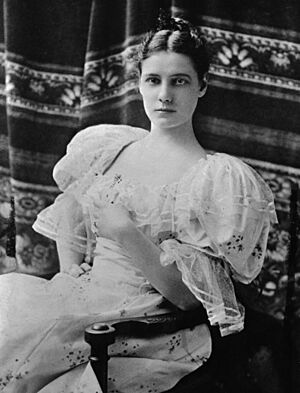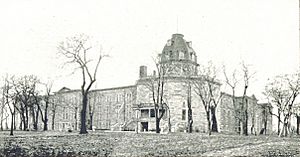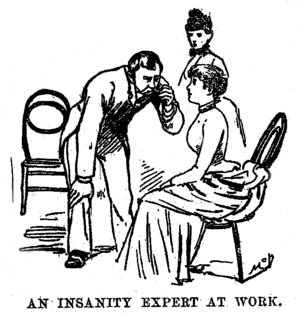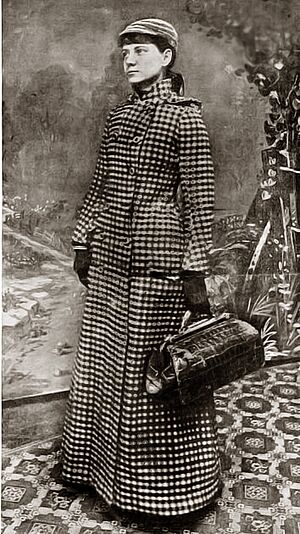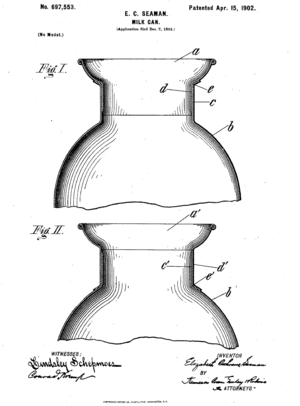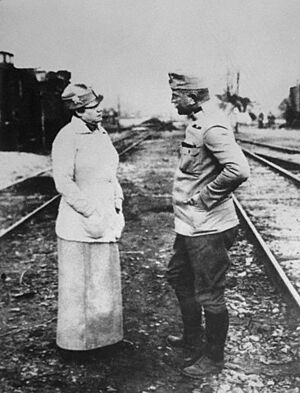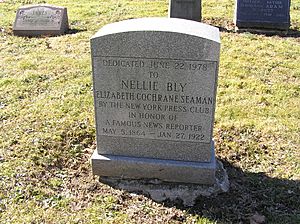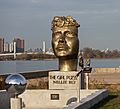Nellie Bly facts for kids
Quick facts for kids
Nellie Bly
|
|
|---|---|
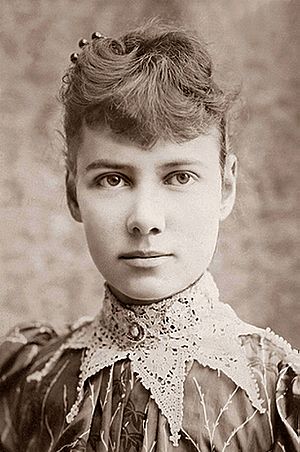
Elizabeth Cochran, "Nellie Bly", c. 1890
|
|
| Born |
Elizabeth Jane Cochran
May 5, 1864 Cochran's Mills, Pennsylvania, U.S.
|
| Died | January 27, 1922 (aged 57) New York City, New York, U.S.
|
| Nationality | American |
| Occupation | Journalist, novelist, inventor |
| Spouse(s) |
Robert Seaman
(m. 1895; died 1904) |
| Awards | National Women's Hall of Fame (1998) |
| Signature | |
 |
|
Elizabeth Cochrane Seaman (born Elizabeth Jane Cochran; May 5, 1864 – January 27, 1922), known as Nellie Bly, was an American journalist, inventor, and charity worker. She became famous for two big achievements. First, she traveled around the world in just 72 days, inspired by a fictional book. Second, she went undercover to expose the terrible conditions inside a mental hospital.
Nellie Bly was a true pioneer in journalism. She helped create a new type of reporting called investigative journalism, where reporters deeply explore a topic to uncover the truth.
Contents
Early life and first steps in journalism
Elizabeth Jane Cochran was born on May 5, 1864, in Cochran's Mills, Pennsylvania. When she was young, people often called her "Pinky" because she loved wearing pink. Later, as a teenager, she changed her last name to "Cochrane" to sound more grown-up.
In 1879, she went to Indiana Normal School but had to leave because her family ran out of money. In 1880, her family moved to Pittsburgh. One day, she read a newspaper article called "What Girls Are Good For." It said girls were mainly for having children and taking care of the house. Elizabeth was very upset by this. She wrote a strong letter to the newspaper, the Pittsburgh Dispatch, signing it "Lonely Orphan Girl."
The editor, George Madden, was so impressed that he asked her to reveal herself. When Elizabeth met him, he offered her a chance to write for the newspaper. Her first article, "The Girl Puzzle," talked about how divorce affected women. Madden was impressed again and offered her a full-time job. It was common for women writers at that time to use pen names. The editor chose "Nellie Bly," from a popular song. He accidentally spelled "Nelly" as "Nellie," and the name stuck.
Career highlights
Reporting for the Pittsburgh Dispatch
As a writer for the Pittsburgh Dispatch, Nellie Bly first wrote about the lives of women working in factories. She wrote a series of articles that investigated their difficult conditions. However, factory owners complained about her stories. So, the newspaper moved her to the "women's pages," where she had to write about fashion, society, and gardening. This was a typical role for women journalists then, and Bly was not happy with it.
Still only 21, she wanted to do something amazing. She decided to travel to Mexico as a foreign correspondent. She spent almost six months there, reporting on the lives and customs of the Mexican people. Her articles were later published in a book called Six Months in Mexico. In one report, she criticized the Mexican government for jailing a local journalist. When Mexican officials found out, they threatened to arrest her. Bly had to quickly leave the country. Back home, she bravely accused the Mexican leader, Porfirio Díaz, of being a dictator who controlled the press.
Undercover at the asylum
After returning, Bly was again asked to write about theater and arts, which she disliked. In 1887, she left the Pittsburgh Dispatch and moved to New York City. After four months of struggling, she convinced Joseph Pulitzer, the owner of the New York World newspaper, to give her an assignment. She agreed to pretend to be mentally ill to investigate reports of cruelty and neglect at the Women's Lunatic Asylum on Blackwell's Island.
It was not easy for Bly to get into the asylum. She stayed up all night to look disturbed and started telling people that other boarders were "crazy." She refused to go to bed, scaring others until the police were called. After being examined by a police officer, a judge, and a doctor, Bly was sent to Blackwell's Island.
Once inside the asylum, Bly experienced the terrible conditions herself. After ten days, The World newspaper arranged for her release. Her report, later published as a book called Ten Days in a Mad-House, caused a huge stir. It led to important changes at the asylum and made her very famous.
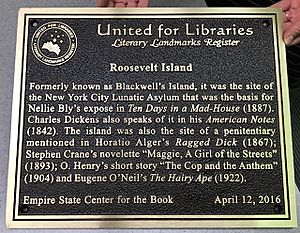
Racing around the world
In 1888, Bly suggested to her editor at the New York World that she travel around the world. She wanted to turn the fictional journey from Jules Verne's book Around the World in Eighty Days into a real-life adventure. A year later, on November 14, 1889, with only two days' notice, she boarded a ship called the Augusta Victoria. She began her 40,070-kilometer journey with just the clothes she was wearing, a warm coat, some extra underwear, and a small bag for toiletries. She kept most of her money in a bag around her neck.
Another newspaper, Cosmopolitan, sent its own reporter, Elizabeth Bisland, to try and beat Bly's time. Bisland traveled in the opposite direction, starting on the same day. Bly didn't even know about Bisland's race until she reached Hong Kong. She wasn't worried about the competition. She said, "If someone else wants to do the trip in less time, that is their concern."
To keep readers interested, the World newspaper held a "Nellie Bly Guessing Match." Readers had to guess Bly's exact arrival time. The grand prize was a free trip to Europe.
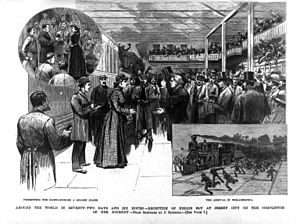
During her trip, Bly traveled through England, France (where she met Jules Verne!), the Suez Canal, Sri Lanka, Singapore, Hong Kong, and Japan. She used steamships and existing train lines. She could send short updates using new telegraph cables, but longer reports had to travel by regular mail, which took weeks.
She faced some delays, especially in Asia. During her stops, she visited a leper colony in China and bought a monkey in Singapore.
Because of bad weather on her Pacific crossing, she arrived in San Francisco two days behind schedule. However, the World owner, Joseph Pulitzer, arranged a special private train to rush her home. She arrived back in New Jersey on January 25, 1890, at 3:51 p.m.
Just over 72 days after she left, Nellie Bly was back in New York. She had traveled around the entire world, almost completely alone. Elizabeth Bisland was still crossing the Atlantic and arrived four and a half days later. Bly's journey set a new world record!
Later life and inventions
In 1895, Nellie Bly married a rich factory owner named Robert Seaman. She was 31, and he was 73. Because her husband was ill, she left journalism and took over his company, Iron Clad Manufacturing Co. This company made steel containers like milk cans. When her husband died in 1904, she became the head of the company.
In 1904, Iron Clad started making the steel barrel that became the model for the 55-gallon oil drum still used today. While some people say Bly invented the barrel, the actual inventor was Henry Wehrhahn.
However, Bly was an inventor herself! She received patents for a new type of milk can and a stacking garbage can. For a while, she was one of the most important women in American industry. Sadly, the company went bankrupt due to mismanagement by a factory manager.
Bly returned to reporting. She wrote stories from Europe's Eastern Front during World War I. She was one of the first women and foreigners to visit the war zone between Serbia and Austria. She was even arrested once because people thought she was a British spy.
She also covered the Woman Suffrage Procession in 1913, a big march for women's right to vote. Her story, titled "Suffragists Are Men's Superiors," predicted that American women would get the right to vote by 1920, which they did.
Death
Nellie Bly died on January 27, 1922, from pneumonia in New York City. She was 57 years old. She is buried in Woodlawn Cemetery.
Legacy and honors
Honors and awards
In 1998, Nellie Bly was added to the National Women's Hall of Fame. In 2002, she was one of four journalists honored with a US postage stamp in a "Women in Journalism" set.
The New York Press Club gives an annual Nellie Bly Cub Reporter journalism award. This award recognizes the best work by a new journalist with three years or less of experience.
In theater, film, and books
Nellie Bly has been the subject of plays and movies. A musical about her called Nellie Bly was on Broadway in 1946. A fictional mouse character named Nellie Brie, inspired by Bly, appeared in the animated children's film An American Tail: The Mystery of the Night Monster.
On May 5, 2015, the Google search engine created a special interactive "Google Doodle" for Bly's birthday. For this, the singer Karen O wrote and recorded a song about Bly, and Katy Wu created an animation to go with the music.
Bly has also been the main character in novels by several authors. She is one of 100 women featured in the popular book Good Night Stories for Rebel Girls.
Things named after her
A board game called Round the World with Nellie Bly was created in 1890, named after her famous trip.
The Nellie Bly Amusement Park in Brooklyn, New York City, was named after her. Its theme was Around the World in Eighty Days. The park later reopened as "Adventurers Amusement Park."
A fireboat named Nellie Bly worked in Toronto, Canada in the early 1900s.
From the early 1900s until 1961, a fast express train between New York and Atlantic City was named Nellie Bly.
Images for kids
-
A steam tug named after Bly served as a fireboat in Toronto, Ontario, Canada.
See also
 In Spanish: Nellie Bly para niños
In Spanish: Nellie Bly para niños


